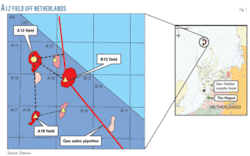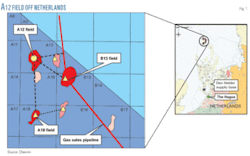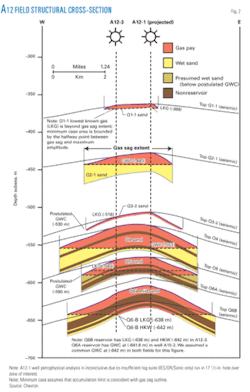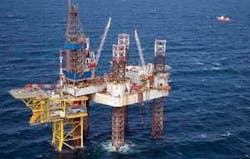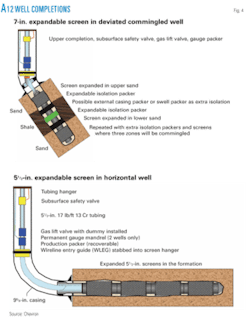Special Report: Sand control unlocks shallow gas formerly regarded as drilling hazard
New expandable sand screens with a close weave have made drilling and completing shallow, unconsolidated gas sands off the Netherlands commercial. In the past, companies often considered these sands drilling hazards and not targets for exploitation.
The Chevron Exploration and Production Netherlands BV operated A12 field is a prime example (Fig. 1).
Fraser Martin, Chevron senior completions engineer, and Mark Nicol, Weatherford regional business unit leader, well screen technologies, provided OGJ with some details regarding the successful development of the field, which Nederlandse Aardolie Maatsschappij BV had discovered in the 1970s while drilling for deeper targets.
Chevron became operator of the field when it merged with Unocal Corp. in 2005. Unocal drilled several test wells, but these wells plugged off with sand during attempts to flow gas from the shallow Pleistocene sands, Martin said.
Chevron’s joint venture partners in the A12 development are Dyas BV, DSM Energie BV, and Energie Beheer Nederland BV (EBN).
A12 field
A12 field is one of five that Chevron has mapped in its A and B blocks. Chevron describes the fields as shallow low-relief anticline structures with the seismic definition obscured by gas chimneys and glacial features.
The fields contain six to seven sands with total pay thickness of 80-125 ft. Sands in the A12 field are at a 1,500-2,200 ft subsea depth with some sands having a gas-water contact (Fig. 2).
The fields are in relatively shallow 90-150 ft of water.
A12 is the first field development for Chevron in A and B blocks and the company has plans to commence in 2010 a second phase with a similar design and well numbers. A12 is about 280 km north of Den Helder.
Chevron used batch drilling from the Noble George Sauvageau jack up to drill and complete the wells on the A12 central production platform (Fig. 3). The batch-drilling process involved drilling all 121/4-in. holes for the seven wells and setting 95/8-in. casing at the top of the sands before drilling and completing the productive intervals in each well.
Martin said that the jack up drilled and completed the seven production wells in a fast 150 days.
The four-pile production platform is in 98 ft of water and includes three-stage compression for moving the low-pressure gas from the wells into a pipeline connected to the A6-F3 pipeline that connects to the Northern Offshore Gas Transport (Nogat) pipeline. Nogat also transports gas from Norway to Den Helder.
Martin said the bottomhole pressure of the lower sands of A12 is about 960 psi at 1,400 ft.
Completions in five of the wells have 81/4-in., 1,000-ft horizontal laterals with 51/2-in. expandable 120-µm screens, while two of the wells are deviated completions that allow zonal isolation of commingled zones through 7-in. expandable 120-µm screens in an 81/2-in. hole (Fig. 4).
Production from the wells started on Dec. 20, 2007, and Martin said that all the wells are producing and operators have detected sand in only one zone of the 7-in. completed well, which has sanded up. The test separator on the platform has a 10-µm filter for monitoring sand production from the wells.
The seven wells currently produce a maximum 120 MMscfd. During 2008, available NOGAT pipeline capacity limited production from A12 to 111 MMscfd, but Martin said projections are that available capacity in NOGAT will increase in the future and allow more gas production from A12 wells. For 2009, Chevron estimates production will be 125 MMscfd.
Martin said each well is capable of producing 20-25 MMscfd with a 45-psi drawdown and Chevron estimates that the field contains about 280 bcf of recoverable gas. The produced gas is about 98% methane.
Screen selection
Martin said that that A12 was the first North Sea field in which Chevron has used expandable screens and that the company went through an extensive selection process before running them. Two rejected technologies were frac-packs and gravel packs, deemed not appropriate for the shallow depths and low pressure of A12 sands, Martin said.
As Nicol explained, industry has had expandable screens available for several years but Weatherford’s recently developed 120-µm were the ones that proved effective for A12 wells.
Nicol said that Weatherford has installed more than 550 expandable screens worldwide but most had larger 150-200-µm weaves.
He added, “The small size of the sand grains in the formation made this one of the most aggressive sand-control applications yet performed using expandable sand screens.” The formation is a very fine sand with an average grain size (D50) of about 63 µm. About 30% of the sand consists of fines less than 45 µm in diameter. Applications at this extreme end of the scale accounts for less than 5% of all expandable screen jobs performed by Weatherford, Nicol said.
Nicol explained “The small sand particle sizes and unconsolidated nature of the formation makes it very difficult to control sand production. Doing so requires finding a balance between the screen’s weave size and acceptable solids production—screens must control the sand without becoming plugged by smaller size fines or producing too many of these fines to the surface.”
For these sands, Nicol said expandable screens were superior to gravel packs because, as a surface filter-vs.-a gravel-pack depth filter, there is less chance of formation damage from fluid invasion and less risk of sand control plugging.
Martin added “The primary limitation of openhole gravel packing in the A12 project was the low frac gradient in the reservoirs, which increased risk of fracturing the formation during pumping operations.” Logistics for gravel packing also concerned Chevron because of the long distance to the shore base. Gravel packing would have required intensive operations for its downhole components and surface equipment, Martin said.
Logistics also were a concern for batch drilling and completing the wells, he said.
Nicol explained that expandable screens mitigated these logistic concerns in that the screens expand against the formation to retain hole integrity and control sand so that the operation does not require pumping to place gravel.
He added, “Weatherford’s experience and data suggest expandable-screen completions have low skin, typically less than one, compared with gravel pack damage that can exceed a skin of five. Weatherford believes the expandable systems should offer equivalent sand control with higher well productivity.”
Martin said that Chevron rigorously tested various alternatives before determining to use the 120-µm screens. The testing included slurry tests that pumped sand systems through various screen samples to examine retention and plugging tendencies.
Martin said “These tests showed significant plugging of the screens and the potential for severely limited well production and longevity. As a result, it was determined that sand control would benefit from the borehole support provided by a formation-compliant screen.”
Martin noted that conformance testing on a range of screen types and sizes showed the wellbore support improved success, with 93-98% of the formation sand retained. “This testing validated the importance of compliant screens in preventing formation failure and the remixing or resorting of sand particles that could lead to plugging,” he added.
Nicol explained that compliant expandable screen systems are designed to directly retain 10% of the formation sand (the D10 designation) and use larger size particles to retain smaller sizes by creating a stable arch. “This provides excellent sand retention capability without adversely effecting performance as the result of plugging by the small particles,” he said
Chevron also tested products with different weaves from several vendors but found that Weatherford’s 120-µm screen, the only expandable screen with this weave size commercially available, exhibited the best performance, Martin said.
